Hungarian Hot Wax 'Banana' Peppers - Harvest & Pickling
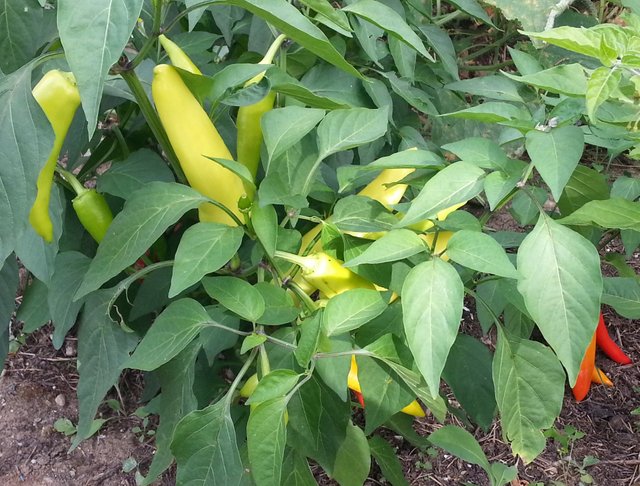
Peppers - Capsicum Annnuum
I'm growing four varieties of 'capsicum' peppers this year. Starting on the left in the picture below, you can see the cayenne hot pepper plant, the hungarian hot wax banana pepper plant, the maya hot pepper plant, and the the mini bell pepper plant.
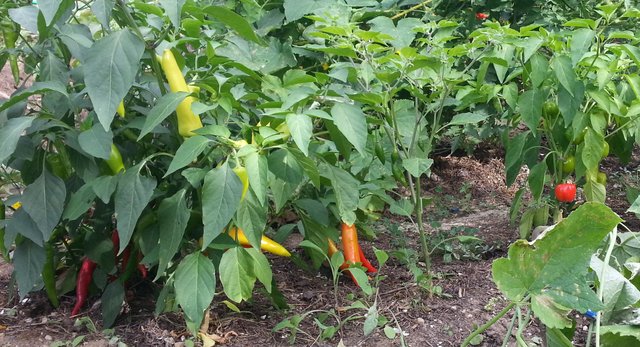
Capsicum annuum peppers are native to South America, Central America, and Southern North America. They have been grown around the world for more than 400 years. The hot capsicum peppers, like the banana, cayenne, and maya hot peppers are often referred to as chili peppers.
Hungarian Hot Wax Banana Peppers
Hungarian Hot Wax Banana Peppers are tasty on pizza, sandwiches, salads, pickled, with snack platters, relished, and with many other recipes where sweet and tangy heat is desired. The heat is mild, 0-1000 on the Scoville heat unit scale, and doesn't over power the taste of the food it is eaten with. They are typically sold as bright yellow. Banana peppers are first green with no heat, then gain their heat and change to yellow, orange, then red. They are fully ripe when red and a little soft. Yellow banana peppers are as hot as the red ones, but the red ones are sweeter.
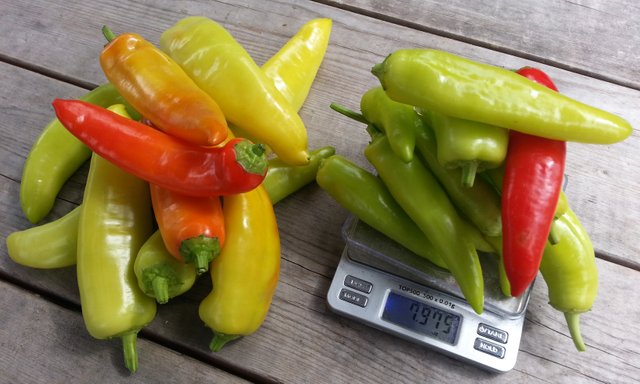
Nutritional Information
Banana Peppers are anti-inflammatory, anti-oxidant, have a high Capsaicin and vitamin C content, contain a substantial amount of Vitamin B6, and have a small amount of vitamin A, iron, and potassium. I enjoy the taste and anti-inflammatory properties of banana peppers the most. If I'm ever feeling sluggish, hot pepper rings added to the next meal will provide a jump start.
According to research, this substance is generally considered safe to use in the amounts usual found in food, however, in some rare cases, it may cause some side effects, such as – stomach pain, sweating, diarrhea, a runny nose, flushed skin, and tears.- Banana Peppers - Health Benefits, Nutrition Facts, and Side Effects
Capsaicin Content / Scoville Heat Index
Capsicum Peppers contain capsaicin - The more capsaicin they contain, the hotter the pepper will be. Below is a list of hot peppers arranged by their Scoville Heat Unit.
| Scoville Heat Unit | Capsicum Annuum Pepper Varieties |
| 0 to 100 | Bell pepper, Pimento |
| 100 to 1,000 | Banana pepper (pepperoncini), Paprika, Cubanelle |
| 1,000 to 10,000 | Poblano, Pasilla, Tabasco brand sauce, Chipotle, Jalapeño, Guajillo pepper, |
| 10,000 to 100,000 | Serrano, Malagueta pepper, Cayenne pepper, Manzano, Tabasco pepper, Chiltepin |
| 100,000 to 350,000 | Maya, Habanero, Scotch Bonnet |
| 350,000 to 800,000 | Red Savina habanero, Chocolate habanero |
| 800,000 to 3,200,000 | Bhut jolokia (ghosts pepper), Pepper X, Trinidad moruga scorpion, Carolina Reaper, Dragon's Breath, Naga Morich, U.S.-grade police pepper spray |
| 16,000,000 | Pure Capsaicin |
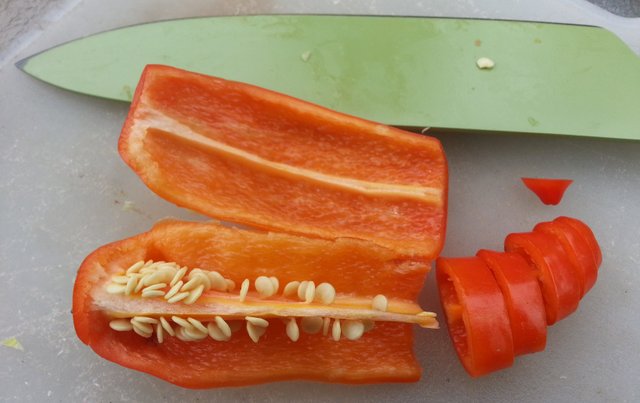
Growing Banana Peppers
Pepper plants enjoy warm and dry climates climates with full sun. They can be grown in cooler climates when started early - inside or in a greenhouse - before spring. Seeds from ripe peppers are the most likely to be viable and can be stored in a cool, dark, and dry place for planting the next year. New plants can also be started from branch cuttings.
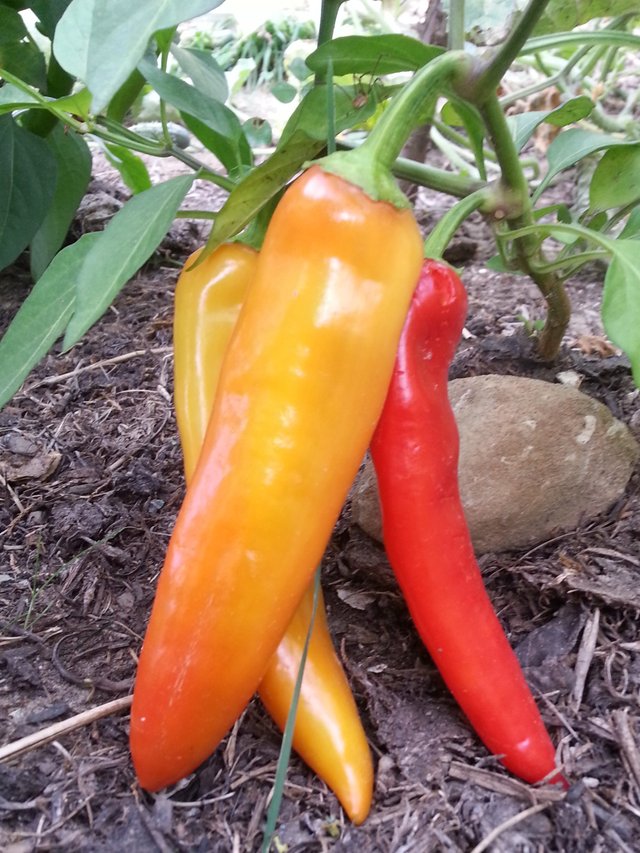
|
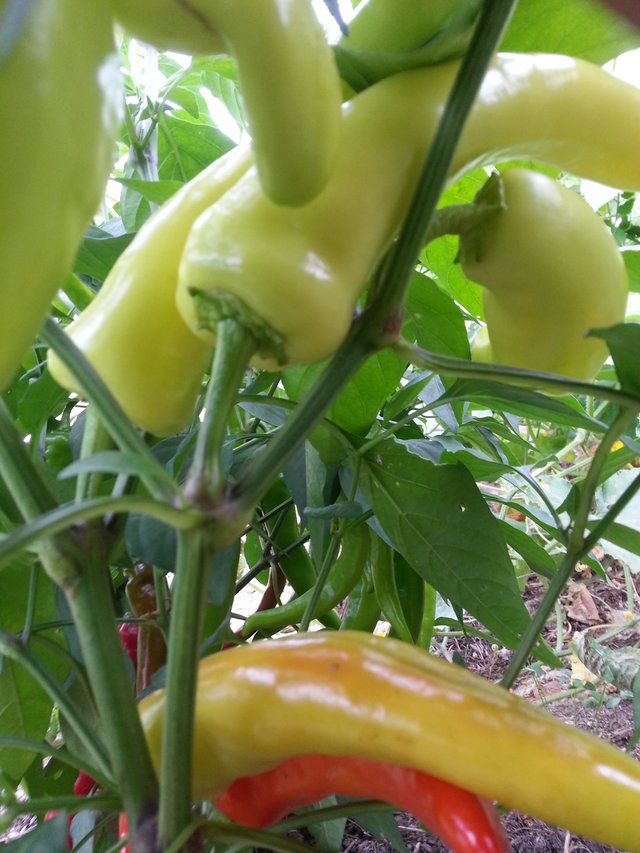
|
Banana Pepper Harvest
Banana peppers can be harvested when they are green, yellow, orange, or red. Simply snip the stem just above the pepper.
|
Harvest |
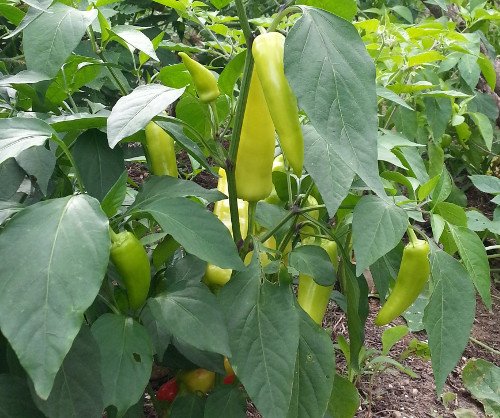
|
Pickling Hot Peppers
Ingredients:
- 1-1/2 lbs (680 g) Hungarian "Banana" Hot Peppers
- 4 cups (1000 ml) White Vinegar
- 1-1/2 cups (375 ml) Soft Water
Yield: 3 x 500 ml Jars
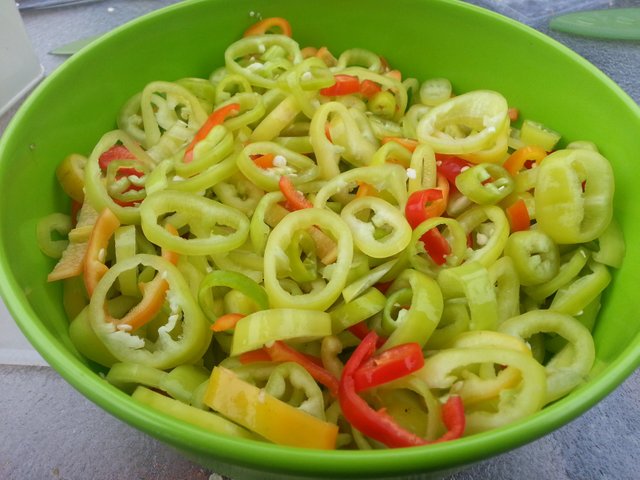
Jar and lid sterilization
The jars have been washed, rinsed, then submerged and boiled in the stock pot to sterilize them. The jars are emptied and removed with the regular tongs.
You can see the lids and threaded bands sterilized in the picture below. Boiling water is not required for sterilizing the threaded bands and lids - boiling water sterilization can damage the seal on the lid - simmering water (82C / 180F). We placed the lids and threaded bands into the bowl, then filled the bowl with simmering water from the boiled kettle.
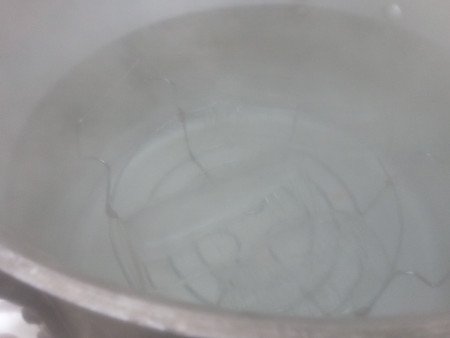
|
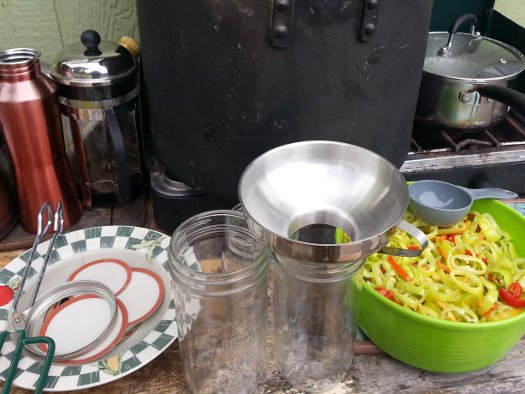
|
Prepare Pickling Liquid
- The hot pepper pickling liquid ingredients are added to a sauce pan and brought to gentle boil for 15 minutes
- The burner is turned off
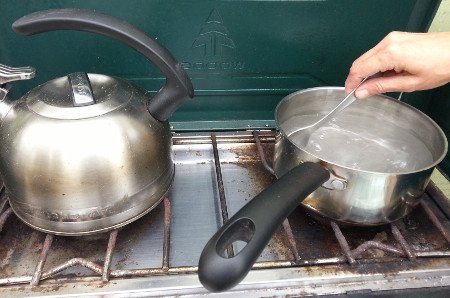
|

|
Pack Peppers
- Hot Pepper rings or whole hot peppers poked a few times with a fork are evenly packed into the sterilized jars to 3/4 inch (2cm) from the top of the jar rim
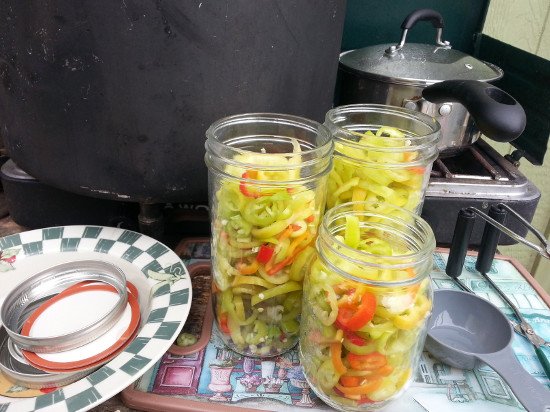
|

|
Fill Packed Jars with Pickling Liquid
- With the help of the jar funnel, a ladle or measuring cup us used to fill the sterilized jars with the pickling liquid
- Peppers should be packed to 3/4 inch (2cm) from the top of the jar rim
- The pickling liquid should be 1/2 inch (1cm) from the top of the jar rim
- Wipe any debris from the jar rim
- Place the jar lid onto the jar rim
- The jar will be hot, using the jar gripper tool or dry cloth to steady the jar, tighten the threaded band onto the jar
- Set jar aside until enough are ready for the jar pasteurization step
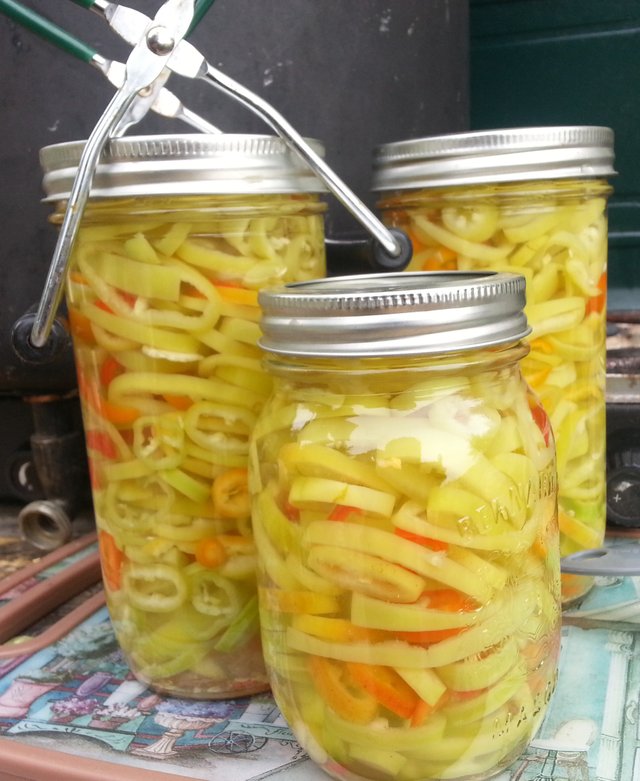
Pasteurizing the Contents of the Jars
- After the banana peppers have been packed into the jars, they are placed into the basket in a stockpot with water filled to an inch above the tops of the jar lids. The stockpot water with the jars is brought to a rolling boil - 100C (212F) - 1 Liter jars for 15 minutes, 500 ml jars for 10 minutes . This pasteurizes the contents of the jars - killing all bacteria and spores, molds, and yeasts. Note: For altitudes 1,000 feet above sea level, 116C (240*F) boil must be maintained with a pressure cooker to pasteurize the contents of the jars.
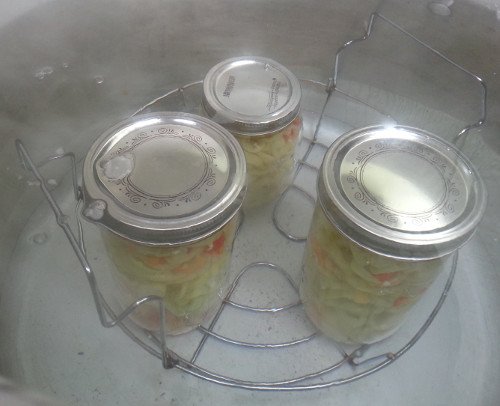
|

|
- After the jars have been rolling boiled for 15 minutes, the burner for the stock pot is turned off
- Jar tongs are used to carefully remove the pasteurized jars from the hot water
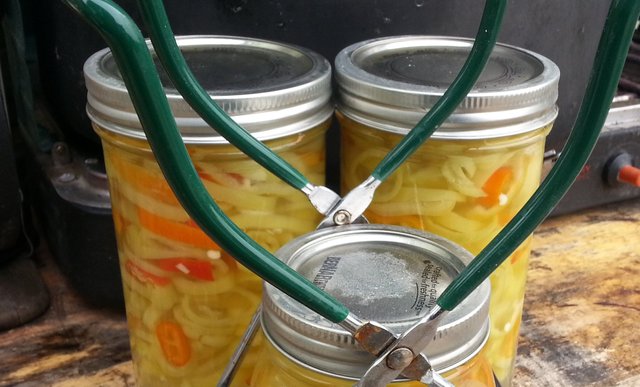
|
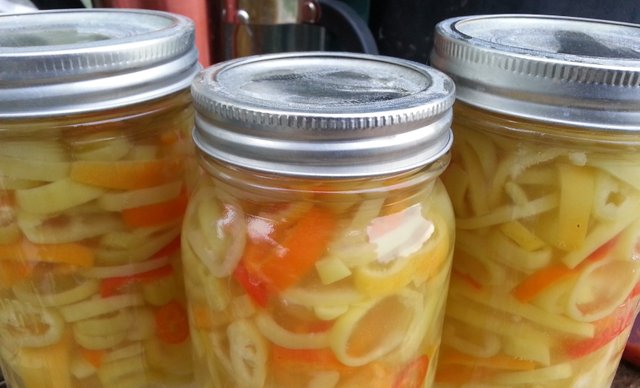
|
Seal Check and Storage
- After the jars have cooled, they are best stored at a cool 10-21C (50-70F) in a dark room or cabinet. After 24 hours the jar seals are checked - the lids should indent downwards and not pop up when pressed. At this time the threaded bands are removed and wiped along with the jars. The bands can be loosely screwed back onto the jars, or set aside.
Hot Peppers for the Year
Last year I went through a little more than two jars of banana pepper rings, so with this small harvest and hot wax banana pepper ring pickling session, there should be plenty to munch on until the next harvest.
Previous Garden Posts this Season:
- Dehydration Preservation - Five Cherry Tomato Varieties + Basil & Tomato Infused Olive Oil
- Giant Puffball Mushroom - Edible, Huge, We thought it was a Volleyball
- Preserving Cucumbers as Fresh Pack Pickles - Sweet and Dill Varieties
- https://steemit.com/gardening/@jackdub/cucumber-garden-update-growing-tips-and-uses-first-harvest
- Harvesting Oregano for Food Seasoning and Well Being + How to Propagate

I upvoted your post.
Best regards,
@Council
Posted using https://Steeming.com condenser site.
UPDATE: Hi @jackdub this post has been featured in Exponential! C² Featured Posts, a daily publication of the @c-cubed blog. Check it out :)
https://steemit.com/curation/@c-cubed/exponential-c-featured-posts-september-20th-2018
This post was shared in the Curation Collective Discord community for curators, and upvoted and resteemed by the @c-squared community account after manual review.
I like hot peppers, too. Jalapeno is plenty of heat for me. Habanero is just pure pain.
Posted using Partiko Android
Me too, I like to be able to taste and enjoy the other food too :)
This is awesome @jackdub. Its inspired me to grow more peppers this year so I can pickle them!! Thanks so much for sharing. They look so healthy and delicious..!!
Thanks - i do like cucumber pickles, but if I had to choose, it would be hot pepper rings. Those 3 jars are from 3 small to medium size plants - it wouldn't take much to get a decent harvest :)
Great post @jackdub! following you is like a subscription to an e-magazine. Love your how-to posts. Very high quality photos and I still love the .gifs I'm surprised you are able to grow as many peppers as you do in Canada. I guess you alluded to getting a head start indoors . I remember when I lived in New Orleans the bell peppers did great but some of the other peppers wanted even more sun than Louisiana could offer. We always kept canned fruits and veggies in the basement or cellar when I was growing up and we canned a lot. One thing I remember is you always check the lid to make sure it hasn't "popped" when you are opening the can too. Not just when finishing canning. But I suppose that is obvious :)
Thanks @steven-patrick - I started the peppers indoors in april this past year, but this year i'll be starting them in feb or march to give them even more of a head start. For sure never eat shelf preserves that appear to have a broken seal or packaging - that's good advice :)
Aren't those pepper plants looking gorgeous? I always think it' such a shame that we don't eat peppers, because I'm madly in love with the plants
Great Job @jackdub - It's always great to have some extra 'spice' to zing things up! I had a chilli plant once, they're great as a first plant too as they produce a big crop for their plant size.
I found that my plant only yeilded after 2 years...
@resteemator is a new bot casting votes for its followers. Follow @resteemator and vote this comment to increase your chance to be voted in the future!